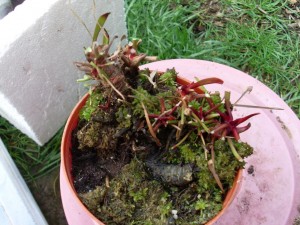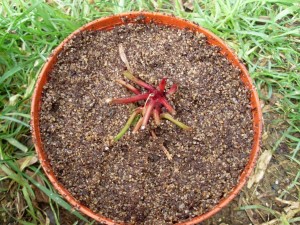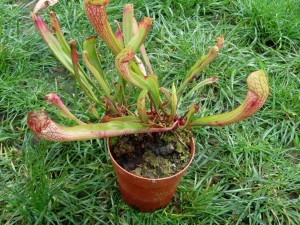Article by Adam Strath aka strath76 - Melbourne, Australia
Providing a dormancy period in tropical regions can be very challenging. Without the distinct seasons (summer and winter) that plants have evolved with you often fail to get the best from your plants. This is intended as a guide to replicating these conditions in order to improve your plants chances of survival and also to help them thrive.
Sarracenia’s generally flower as they emerge from dormancy. In order to ensure that you get the opportunity to see them flower it is imperative to provide a dormancy or rest period. Further to this, if plants are not given a rest and are forced to grow continuously they will eventually exhaust themselves and die.
The first thing that you need to work out is when the plants should become dormant. There are a couple of options here. If you are fortunate enough that your plants begin their own dormancy you only need to identify the signs. Most plants simply stop growing when they become dormant. If you have an oreophila or possibly a flava then your plants may produce phyllodia. These are modified leaves that are non carnivorous. Flava plants produce these as they are going into dormancy and oreophila usually produce them a couple of months before going dormant. If you don’t have these signs but your plant has been growing strongly for 6 months or more than you can induce the dormancy at anytime your self by following this guide.
If you have a large fridge with plenty of space you can simply remove the pitchers from your plant and seal it in a zip lock bag and place the whole thing in the fridge. Ensure the media is just damp as if it is too wet the plant may rot. If you have limited space then you should remove the plant from the pot as described below. I have included a few pictures to better demonstrate what I have written.
The first step is to remove the pitchers from the plant. This may seem drastic but they will return for you even better the following season.

After you have done this you remove the plant from the pot and carefully remove the potting media from the roots. You should do this carefully to avoid causing too much damage to the roots. If the roots are very long or there is a thick mat of them you can trim them to make it easier to handle.

The next step is simply wrapping the roots in moist (not wet) sphagnum moss for protection and placing in a zip lock bag. It is a good idea to write the name of the plant and the date that you place it in the fridge as it is easy to loose track of things later on.

Once this is done you simply place the bag in the fridge (not the freezer) and leave it there for 6-12 weeks. I prefer 8 weeks as it gives the plants a good rest. After this period is over you simply remove the rhizome from the bag and repot.

If the rhizome is large and has multiple growing tips you may like to divide the rhizome at this stage. You should keep a record of when you put your plants into dormancy so that you can maintain the same timeframe for your plants each year. This way the plants will become accustomed to your ‘seasons’.
Question: Wouldn’t the plant be in shock if you suddenly remove the plant from its hot conditions and put it in the fridge?
It will be a bit of shock to your plants but they can and do experience extremes in temps inthe wild. Providing the plants are relatively healthy and not too stressed they should handle it OK. Your suggestioin of moving it into a cooler, darker place for a while before hand ceretainly wouldn’t hurt them. They do however need the cold temps to get the best out of them.
This is intended as a guide and you are welcome to try it. I have grown Sarra succesfully in temperate areas of Australia where the daytime temp is low 20’s and overnight Temp’s drop to 0 and there is a frost. The plants are not effected negatively by this. Generally the drop in temp will only be a problem to existing traps. These are accustomed to certain temps and the drop in temp can lead to tissue damage. As these are removed you don’t have to worry about that. The rhizome is a very tough structure that will not be adversely effected by this treatment. I would advise you to experiment with one of your plants and see how it goes. Remember nothing ventured nothing gained.
In regards to the seed you do not need to acclimatize these. Mine go straight from the fridge into the glass house. Whilst I am not in the tropics here the temps at sowing are usually around the mid 20’s and I get good germination.
As for my potting mix, I use 50:50 peat and coarse sand. I hope you try the method out i am sure you wont be disapointed. Cheers.

